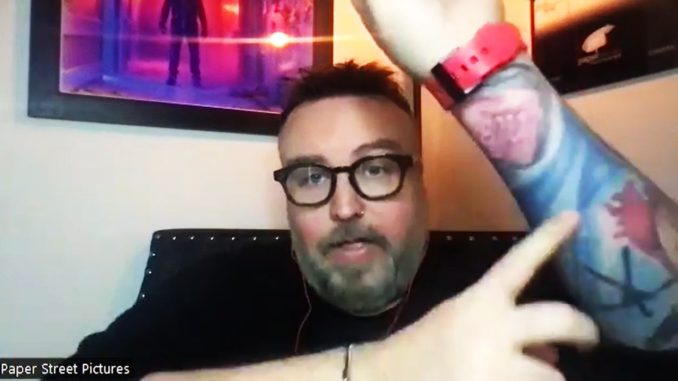
Coming out of nowhere, the anthology movie Scare Package became something of a cult item in 2020. It delivered a smart yet loving deconstruction of genre tropes, from slashers to spam in a cabin. Three years later, the sequel arrives on Blu-Ray, doing much the same thing for the biggest trope of them all: the horror sequel. We spoke to one of the series’s founding father, Aaron B. Koontz – and as you’ll see in the 4,500 words which follow, there was a lot to talk about! Though we could easily have keep going for even longer… Find out about the perils and joys of practical effects, the impact Jaws had on Aaron, and the Blu-Ray bonus feature of which he’s proudest.
It’s obvious from both films that you are a big horror fan. When did you get into the genre initially, and what triggered it, when you were growing up?
I love this question, because definitely, through and through I am. But I grew up in a Christian home and I actually wasn’t allowed to watch horror films, so I had to sneak around to do it – which honestly probably contributed to part of the fandom that I have now. But there were a couple of incidents that really kind of shaped it. First was, my grandmother got HBO for free. After school, my mom worked, so I would have to go there for a few hours until my mom got off work. And I would always take a VHS tape with me, sneak into the guest bedroom, put the tape in and record overnight. The next day I would swap out the tapes. And what played on HBO those evenings was always horror films. I definitely got to dive into some of that there.
Another thing was a night after a church service, and we were renting a movie. It was like a Monday, where we didn’t have school, and my friend Matt White came over and we were renting a few movies from the grocery store – I’m dating myself here, everybody used to do that. I remember I snuck in a few movies and I snuck Alien in to the group while she was paying for the groceries. So we got to watch Alien. Then the third experience was, we went and saw, I think it was Howard the Duck, at a drive-in theater – which is great in its own regard, by the way. But I would sit in the moon roof of my dad’s car, sitting up at the top with my feet dangling down on the car, and behind us they were playing Nightmare on Elm Street. I don’t remember which one. I just remember like looking behind me and sneaking peeks – I obviously couldn’t hear the audio. But each of these situations when I got to see something, it was just so thrilling.
I loved movies. I would watch movies all the time. It’s what I wanted to do with my friends. I would wanna get dropped off at the movie theatre. I was one of those loiterers. I would just hang out at the movie theatre and talk about movies all day. But I didn’t know that you could have that kind of rush watching a horror film. And I think I’ve kind of been chasing it ever since. It’s just been in my DNA in some way, ever since all of that.
So what led you to move from being a fan of horror movies to being a horror movie filmmaker?
I didn’t really know it was possible. My all-time favorite film is Jaws: I have a Jaws tattoo and everything. But at the time, I didn’t realize that it was a horror film. As a kid, it scared the hell outta me, but it just had not fully connected, that’s what it is – it’s a monster movie, right? My aunt bought a book that had a number of articles about making movies and it had pictures from behind the scenes of Jaws, and I was so fascinated. I knew that they had to get a camera. But I was, “They’re in the water, how is this possible?” Or, “The shark’s not real, but how do you make that?” It was all confusing.
I saw this image, and it was Steven Spielberg. He’s standing on a platform, he’s got a megaphone and there’s a mechanical shark that’s broken and it’s half sticking out of the water – -you can see these big wheels. I was “Oh my God, this is amazing. Look at all these people and what they’re doing. Who’s that guy with the megaphone?” I was told that is the director, Steven Spielberg. He’s making these decisions and putting this together. And I was, “That’s a job?”
So it totally changed everything for me. But I will say, going through high school and even college for a while, that was just like a pipe dream. It didn’t feel like it was really possible. I was actually in medical school first and I dropped out, went to film school, and was “I’m gonna try this.” Worked in freelance for a long time, on film sets. Then finally, there was a moment where I was, “I have to try. We have to make our own thing and do this.” That was when we founded our company [Paper Street Films] – we just had our anniversary – which was 11 years ago, and we’ve been doing it ever since. So there was an itch, I had to scratch it and I’m so glad I finally did. It has changed my life in every way, and I don’t think I could ever go back to not making movies. There’s just something so special about it and it’s a very fulfilling thing for me to have reached this point.
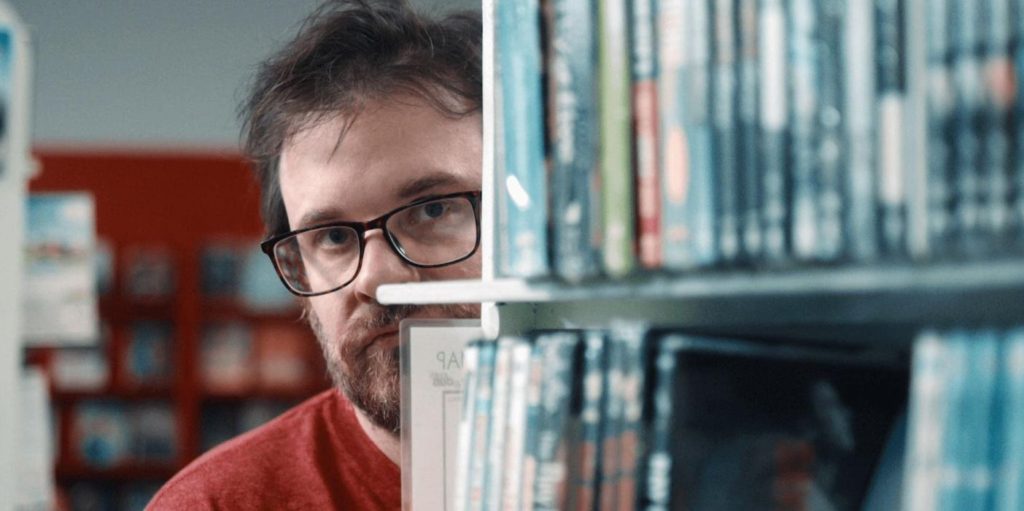
You already had a feature under your belt with Camera Obscura. So what made you decide to go with Scare Package as an anthology rather than a standalone feature?
Camera Obscura was a very difficult process for us. We were very fortunate, we made the movie with NBC Universal, and it played really well internationally. But in the States, my cut of the film was never released. It was super frustrating and I felt very down about it. I had worked so long trying to get that movie made, I’d actually raised a little bit of money on the side: we had to give that money back when, when Universal came in and said they wanted to make the movie. So I had these investors I had already curated, and I went, “You know what? Why don’t we just do this ourselves?”
We had some partners on that film who were very difficult, and I was “Let’s just jump in. If we fall flat on our faces, we fall flat on our faces. Let’s just be very honest about we’re trying to do, but let’s make it our way. It’s gonna be silly, it’s gonna be gory, it’s gonna be ridiculous, and it’s gonna be something we’re gonna have fun doing. And that’s really what Scare Package was. It’s the opposite [of Camera Obscura] in a way. Again, I’m very proud of a lot of Camera Obscura, but it’s psychological horror, a little bit of a downer.
The credits roll on that one and you’re just like, “Ugh.” It’s a gut punch, and I wanted the opposite. Literally the credits roll on the first Scare Package and it’s somebody smiling gleefully ear to ear, running from a car explosion, right? I think we really tried to kind of counter that with something fun, and we had no idea what was gonna happen with it. Now, you know, we’ve got a sequel, people dress up at Halloween in costumes, and there’s people with Scare Package tattoos. It’s really, really crazy and really fun.
How did you go about selecting the filmmakers for that first installment?
When we first got started with Paper Street, we were making a lot of short films, so we worked with short filmmakers. These were just people that I had known, friends of mine, or friends of friends that we had seen. So, Noah Segan – his directorial debut was with us in Scare Package and then we went on to make Blood Relatives with him later. But he was a friend of mine from Starry Eyes. I was a producer on that movie, so we got to know each other there. Emily Hagins was a friend of mine in Austin – it’s mainly where I’m based out of.
For Chris McInroy, in particular, we had seen his shorts at different film festivals, conventions, and I loved what he was doing. Anthony Cousins, same way: we saw his short at Texas Frightmare, got to know him, we played one of our projects there. We were just short filmmakers on the circuit together, and that’s where so much of this came to be. It had to just be people who we knew. We really didn’t want to bring in a lot of big feature filmmakers. I think part of the goal was, let’s just make this really DIY and give opportunities to people to showcase something in a different way. We’ve maintained that focus even into the sequel.

Working with such a large number of filmmakers, was that a bit like herding cats in terms of the process? Or did it all come together into the finished version very easily?
Oh, I wish it came together easily! No, it was extremely difficult. Cameron – my creative partner on this – herding cats is the exact analogy he’s used, so you’re spot on there. What I have realized is that, as I’m kind of moving a little bit into TV now in my career, it is similar to show-running. Because you’re getting these episodic directors that are coming in, but you’re keeping it within a cohesive vision. So it’s kind of in that world, is what we’ve figured out. But, yeah, we do these individually. It’s not like it’s one big shoot, and they all shoot together. We’ll make a short, we’ll see how it turns out. We’ll curate it and then we’ll write things around it.
That’s what was important to me: I wanted this whole thing to feel cohesive. I wanted, when one short ended and before another began, you had something that connected them in a different way, it just didn’t feel like an afterthought. That was important, and what that means is, you have to curate it and you have to take your time. So they do take a very long time to get made, and we’re tweaking right up until the last second. But, it’s part of the charm when you’re able to curate it in a special way, and we’re really proud of that.
You mention “cohesion.” One thing I did notice was technically, the installments look very much in line with each other. Did you ever think about maybe using different formats – shooting on video, shooting on film – or applying grain to get that video-cassette feel?
My friends made the V/H/S series, and had done that: I didn’t want to feel derivative. So it was, “Let’s just keep it a little more crisp.” But it’s still paying homage to that time, especially in the first one which is more eighties horror-centric. So we’re trying to find a way to tap into that, but still make it be modern. But we didn’t want, and we couldn’t afford, to shoot on film – that just would’ve been too expensive for us. So we found that sweet spot. But we did work to try and cut corners in a smart way, so that we’re having the same aspect ratios and we had the same colorist for all the segments. We’re shooting on the same cameras, and a lot of times some of the same lenses. We’re trying to share things to keep cohesion from segment to segment.
But I think that really comes to play in, when story-wise you’re able to interweave, how you go into one segment and how you come out into our main story in a more memorable way. The second film it’s more the opposite. The second film was more, here’s the main story, then we leave and give a segment. Whereas the first is, here’s the segments and then we go back to this main story. We leaned into that a little more when we realized the rad Chad story was what it seemed both the fans and we were really excited about continuing into the sequel.
As a wrestling fan, I was amused to see Dustin Rhodes as the Devil’s Lake Impaler. How did that happen?
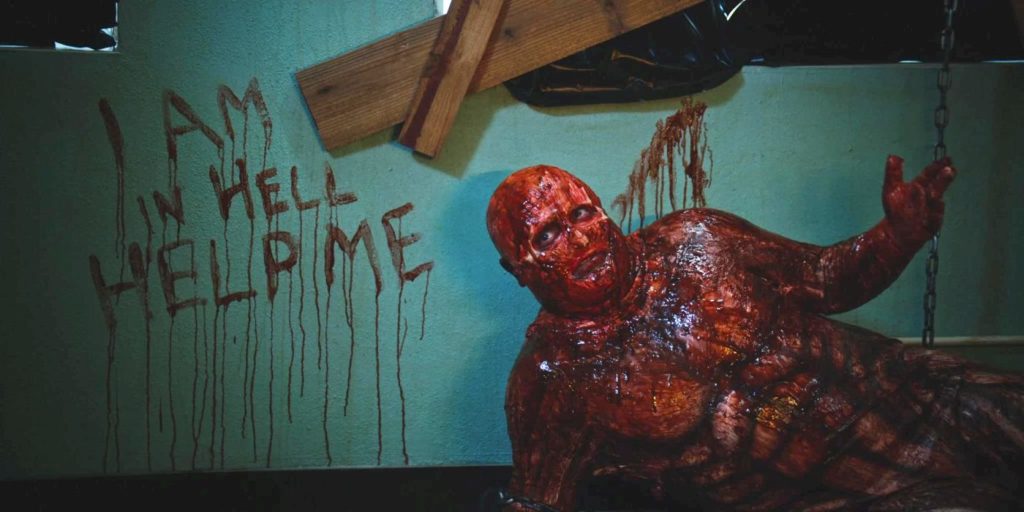 How soon after part one was finished, did you start thinking about doing a sequel?
How soon after part one was finished, did you start thinking about doing a sequel?
It took a while. We joked about making a sequel, but that’s what it was. When we actually finished Scare Package, I didn’t think anybody was going to watch this movie. I truly didn’t. I was, “I really hope people laugh at this. It makes me laugh. It’s funny to us and my film-making friends.” But I truly did not know, because again, we had this experience with Camera Obscura and it did not go the way we wanted. So I was just keeping my fingers crossed, hoping it would land with audiences.
The world premier was at Sitges in Spain, the largest genre festival in the world We were so honored to be there, and we went all the way out to Spain. Then I get my first time slot: it’s one-thirty in the morning when we’re playing. And I’m all, “Oh, my God. What? Who is gonna show up at one-thirty in the morning to see this?” And there was a line wrapped all the way around the building. We completely sold out. We got a standing ovation. I get chills thinking about it. It was such an amazing moment.
I was, “Wow, wait a second – we might be onto something”, but then imposter syndrome kicks in: “Well, that was just a one time thing. They were too tired. They were drunk.” I would come up with all these excuses to justify it. Then we play another festival, and another festival… But we really didn’t know it had a chance to have a sequel, probably until it aired on Joe Bob Briggs for The Last Drive-in, and we got the response there. Still, it was that first week on Shudder and you’re just hoping for numbers, you’re hoping people are watching, that they’re engaging, and it was a huge hit the first week.
After that it was, “Okay, we really do have to make this now.” We had toyed with ideas, but we weren’t serious about it. But then it became, “Wait a second, we killed Rad Chad. We’ve killed Sam. We killed all these people: the Devil’s Lake Impaler blew up. What are we gonna do? How are we gonna make this work?” But that became a really fun place to start from. Let’s lean into the great thing about horror films, which is the horror sequel and how absurd they are. Then we had a framework and we ran with that.
Was it different selecting filmmakers the second time around? I imagine you must have been inundated with pitches.
We definitely were. We had a lot of people who had reached out to us, we had made this master list from the first time and there were a number – there’s still a number – of filmmakers we love, that we want to work with, and we still couldn’t even fit them in the sequel. Hopefully we can keep making Scare Package movies, just so I can work with more of my friends that I love. Honestly, a big part of it was the list we had from the first film.
I specifically wanted to get slightly more global. Rachel Wiggins directed “We’re So Dead,” that Cameron and I wrote, the last of the four segments, We met her that night in Sitges at our premiere; she was there with another project. We became friends, she was going to do the new Wolf Creek sequel and was so proud of where her career was going. Then that fell apart and she was “I don’t know what I’m doing next.” I said, “You should come do Scare Package with us. We wrote a segment. I think it’d be great. Let’s turn it into this Aussie humor and do an Aussie pass on it,” and they got to go shoot that in Australia. I couldn’t be there because of the pandemic, so we had to remotely check in and do all this work, which was tricky, but was so wonderful.
The same thing with Jed Shepherd, whom I’ve known for a little while. We had talked about working together and finding the right project. My pitch to him was, I wanted to do a spoof on [his feature film] Host and I really wanted to do like a whole segment based on Host that continues from it, but making fun of it. That got shot down, but we did have an idea of bringing all the Host girls back in a different realm. I don’t know if it was him or I – I think it was my idea, Jed says it was his! – which was for the Three Men and a Baby ghost that actually comes in to haunt, off a laser disc. Because I had a laser disc and I would pause Three Men and a Baby to see that ghost!

Both films lean heavily into practical effects. Did you ever regret that choice, and across the two films, which were the hardest effect to pull off?
Oh, no: definitely don’t regret it. I don’t mind the time it takes. It’s hard to make movies. People get that, but you’re working overnights on horror films. These aren’t big budget things, so nobody’s making a lot of money. You’re hopped up on coffee and pizza and you’re like, “How can we like survive this?” And what gets people excited is when a big practical gag works on set. Because if it’s VFX, you can’t see what you’re doing. You are, “Okay, I really hope that looks great six months from now.”
But here you’re watching a head explode. You’re vomiting acid blood, you’re watching it spray and hit someone, and everyone’s gathered around the monitor, taking pictures, their phones are all out, and then you’re clapping and you’re cheering, right? I think it just invigorates everyone. So, yes: it takes time. But we’ve gotten really good at how we schedule this, and how we are able to shoot one direction while we’re prepping something else. We really plan in our schedule to make those practical effects work.
They’re all difficult. What Chris McInroy pulled off with the melting man, the “goo guy” (pictured above) in the first Scare Package, was extremely difficult. We had to dig a hole and put the actor physically into the ground, and then all the goo. These ants started like running toward him – and he’s allergic to ants. So we had to be very careful; that was potentially a nightmare. I also killed someone with a treadmill on the first movie. That was just ridiculous. We took a real treadmill, pushed it through a wall, and we’re weight balancing it as we split someone in half – my friend Elizabeth Trieu, it was a blast to kill her there.
In the sequel… God, there’s a lot. Obviously, Graham being the skinned man was very difficult because everything he touched… I have pictures of him, he’s on his cell phone in a bag, because his hands are just… he can’t do anything. He’s drinking out of a straw, everything. You would be, “Where’d Graham go?” Well, he went that direction. You can tell he’s walked that way because anyone can follow him. That was tricky.
But I would say the hardest was the Dream Warriors gag where Sam, played by Byron Brown, is coming out of the TV. The way they did that gag in Dream Warriors was, they actually had a mechanical piece and we did not have the animatronics to do that. So we had to kind of make the arm things, stand him through it and he’s like blue screen underneath. I couldn’t shoot that at the same time that my actors were there. This was the same time they were doing the whole sequence with the bees and everything, with the mask on. So they’re over there doing that, then Sam’s getting ready in the TV, and I would run over and like do some stuff with Sam, shoot something and then run back over. They were rooms right next to each other, and I would run back over and be directing that.
When Sam was standing on the TV, I couldn’t have all the actors, because they were doing the other scene. I was the one standing in the circle giving him eyelines and just yelling the lines back at him. Byron is a wonderful improvisational actor so we’re improvising and riffing back and forth the whole time. That’s why my voice ended up being the puppet, which was not by design. I’m having to voice the people and I’m arguing with him because I know how to push Byron in a good way, to get those reactions out of him. So I kept doing that.
It was really hard because we’re in a 100-plus degree warehouse, and he’s literally melting. All our fans are in the other room with the rest of the cast, so he’s got one little fan next to him. So we’re having to repaint him on and if you watch it, you’ll see his glasses sliding off his face because he is melting under it. So it was wild. Again, I remember I brought people in as we did the last bit and people got to see that in person. Everybody’s clapping and cheering because it was so funny when we were pushing his head through the thing. Those things make it all worth it. They’re very difficult. But I wouldn’t change a thing about it, not for a second.
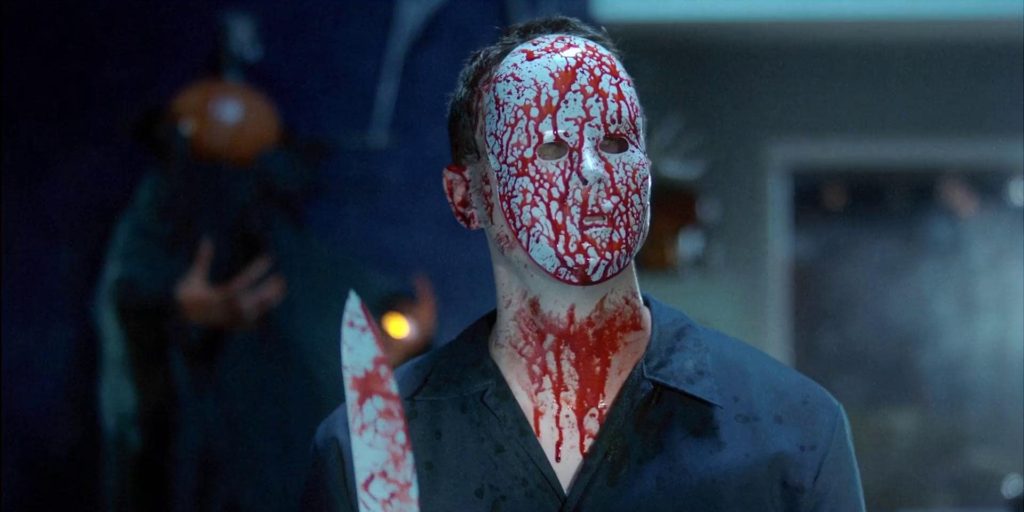
I appreciate this might be like picking a favorite child, but of all the installments across the two movies, which one would you want to highlight?
Oh, goodness! Of all the individual segments? Oh, my gosh. That’s so, that’s so unfair! We’re working together with all these talented filmmakers and doing all these different things. I will say, I definitely have an affinity for what Emily Haggins did in “Cold Open” for the first Scare Package, because it set the groundwork for the whole series. One of the things that I really love about what we do, is we react to what we get in the can. I did not ask her to write a cold open segment. I asked Emily to do something that was just dealing with horror tropes and, and like, let’s talk about different tropes.
And she’s like, I think we could do something that’s like what happens in the cold open. Then after she wrote it, I was, “Ah, well, now this is our cold open. So that makes sense.” Then the character played by John Michael Simpson (above), the Mike Meyers character, once I saw him in the segment, I rewrote him into the ending of the film. Because I was, “Oh, this is great.” I think what’s so special, is when we make these movies, we’re able to listen to each other and respond to what these other talented filmmakers are doing. That changed the way I looked at the other segments, so we got to encourage other people to do other things; that made those segments become more intertwined into everything else we were doing.
I think it was Emily who started the process with “Cold Open”. So I’ll call that out, in kind of a cheating way, because that’s what started it and it literally kicked off everything. I think seeing how she made that work, she nailed the “meta” tone right off the bat. That was really great: it’s like, “Oh my God, this could work. We might actually have something here”. Now we’ve made a sequel and hopefully we can make, we can make a third.
The last thing I would love to highlight, just for the Blu-ray itself, is there some really, really fun stuff. This is a movie that was born out of the VHS store and I used to work at a VHS store growing up, with special features – on the double disk, the VHS, the Blu-ray, the laser disc, all the things I had growing up. We tried to pack this and, and I hope that folks see that. There’s a special feature on the Blu-ray that is kind of like VH1’s “Popup Video”. I don’t know if you remember that from back in the day, but if you watch the movie, it will pop up, in text on screen, every reference to every film that we talk about. It’s just a really fun way to watch it with someone and to re-watch it. I think you can really make a fun game out of it, and we spent a lot of time creating that, so I wanted to highlight that.
What are you working on now?
We are in post on a few films including Trim Season which is this witchy weed horror film starring Beth Million (Sick), Alex Essoe (Starry Eyes), Jane Badler (V) and more. We also have this really special tiny Sci Fi film The Artifice Girl with Lance Henriksen coming out on April 27th. End of the year, at Christmas, there will be A Creature Was Stirring from Damien LaVeck and there is a Sci-Fi horror with Tony Todd and Tobin Bell called The Bunker on its way too. Other than those, which I’m just producing. I am now working on a TV series that I can’t say much about just yet. But it’s a horror-noir that I’m writing and directing. My next feature we are trying to push forward as well – it just depends which gets greenlit first. One is a horror-sports-comedy and the other is a Sci-Fi Body Horror.
Safe to say, I’m keeping busy!
[Thanks to Aaron for his time, and enthusiasm which was both infectious and obvious! Also thanks to Betsy for facilitating the interview]
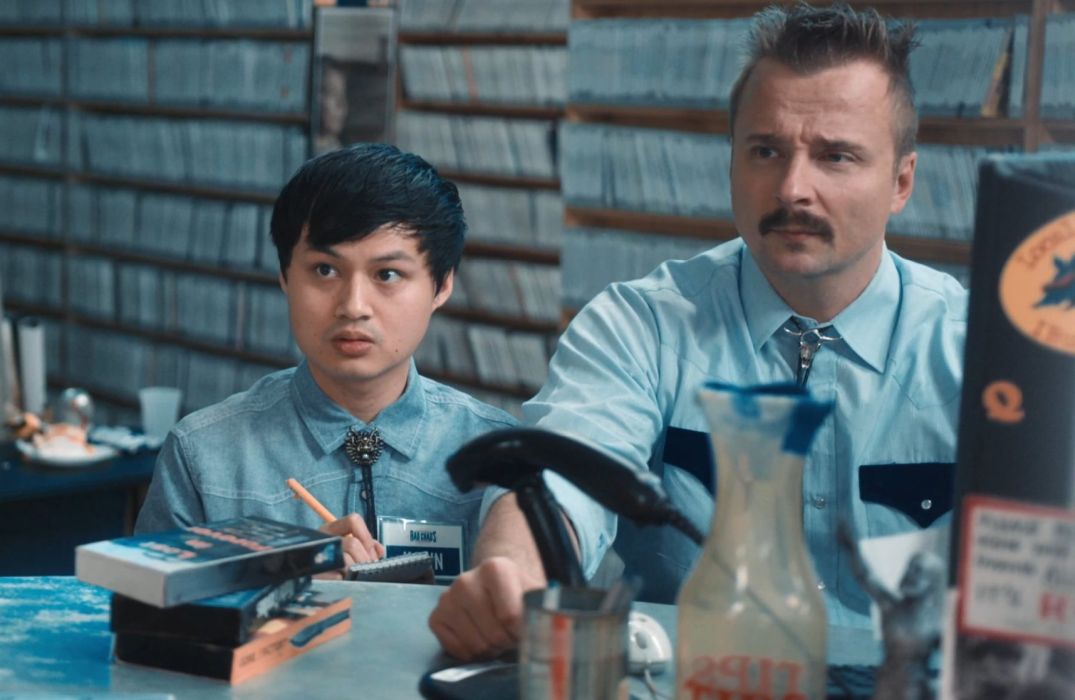
Scare Package (2019)
Rating: B
Dir: Courtney Andujar, Hillary Andujar, Anthony Cousins, Emily Hagins, Aaron B. Koontz, Chris McInroy, Noah Segan, Baron Vaughn
Star: Jeremy King, Hawn Tran, Byron Brown, Jon Michael Simpson
It feels like I’ve reached half my word count, simply by listing all the directors in this anthology. Yet despite the disparate personnel, they do a good job of maintaining a consistent style: if you’d told me all the segments were directed by the same person, I’d have believed you. In terms of content, on the other hand? We run the gamut from A to Z: A as in “awesome”, to Z as in… um, something beginning with Z? It begins very effectively with “Cold Open”, perhaps the most well thought-out story. A background character in horror movies – awkwardly named Mike Myers (Simpson) – dreams of getting a story arc, while stuck doing menial work such as cutting the power to isolated cabins. It’s genuinely inventive, a bit like Free Guy from a horror perspective.
The main wraparound follows, “Rad Chad’s Horror Emporium”, where Chad (King) hires a new employee for his movie store (Tran), and trains them in the way of video (top). This allows for easy segues into the remaining installments, yet is also amusing in its own terms, even if the “throwback video store” has kinda been done to death. Still, I did laugh at the shop having sections for “Evil Clowns” and “Post Modern Feminist Slasher Revenge Body Horror” – the latter containing precisely one title (surprisingly, not directed by the Soska Sisters!). After a superb start, the results thereafter are more variable, so let’s quickly survey what follows:
- “
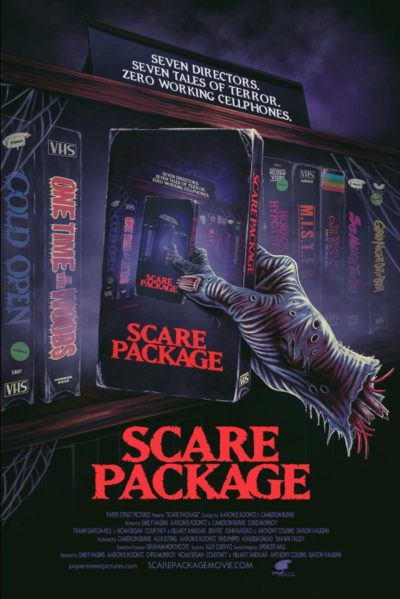 One Time in the Woods” – not much story here, beyond a camping trip going horribly wrong. But definitely makes up for it with some gloriously icky, energetic and practical special effects.
One Time in the Woods” – not much story here, beyond a camping trip going horribly wrong. But definitely makes up for it with some gloriously icky, energetic and practical special effects. - “M.I.S.T.E.R.” – a man joins a men’s rights group, only to find it’s not what it seems. Takes rather too long to get to where it’s going, and not particularly worth the wait when it does.
- “Girls’ Night Out of Body” – a demonic lollipop possesses a group of women on a weekend getaway. I have no real idea what the point of this was, since it was neither particularly amusing nor horrific.
- “The Night He Came Back Again! Part IV – The Final Kill” – A pointed segment on the difficulty of really terminating horror movie killers. This concept should ring a bell with just about every genre fan, and is a load of fun.
- “So Much to Do” – Someone gets highly upset about spoilers. Again: not sure why this was included, it left me neither shaken nor stirred.
- “Horror Hypothesis” – Circles back to Chad, who finds himself stuck in a horror movie, being pursued by the Devil’s Lake Impaler (played, out of costume, by WWE’s Goldust!). Takes “meta” to an almost insane degree, to the point even I could apprecuate it. I certainly can’t argue the accuracy of the tropes it targets.
It’s in the nature of anthology movies to always be variable: in effect, they’re multiple little films in the same package. Yet I’m not sure I’ve ever seen one which covers quite such a range of outcomes. It is the case that individual mileage will vary: maybe you’ll like the ones I hated, or vice versa. Regular readers will know I’m not normally a fan of self-referential horror, considering Scream to be more annoying than anything. Yet I’ll confess that the approach here works, poking fun, in an appreciative way. Even if some of the results fall rather flat, I think the ones which succeed are stellar, and more than make up for the less successful.
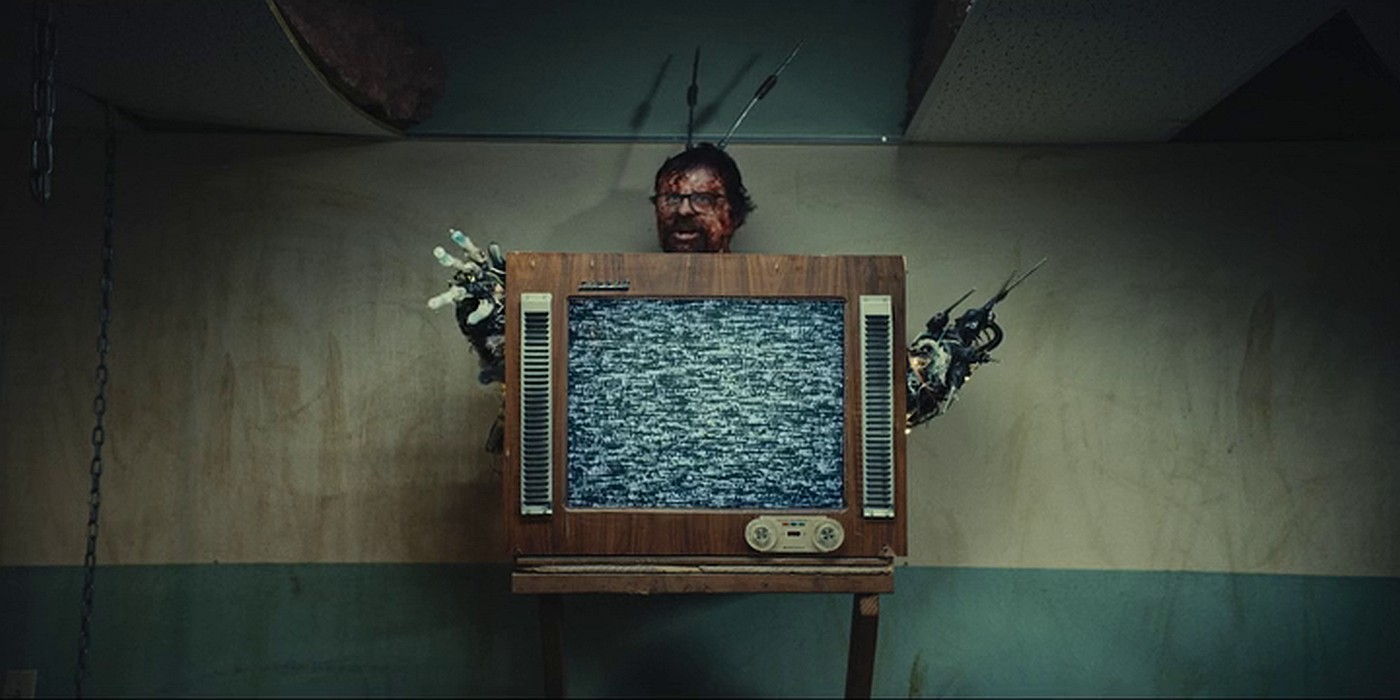
Scare Package II: Rad Chad’s Revenge (2022)
Rating: B-
Dir: Alexandra Barreto, Anthony Cousins, Aaron B. Koontz, Jed Shepherd, Rachelle Wiggins
Star: Jeremy King, Chelsey Grant, Stef Estep-Gozalo, Luc Barrett
If you thought the death of video proprietor “Rad” Chad Buckley (King) at the end of part one, would stop him from showing up in the sequel… THINK AGAIN!!! For this unfolds at his funeral, which begins with a video message from Chad, but quickly degenerates into a Saw-like procession of tricks and traps for the attendees. This is your framing device for four more horror shorts, most of which poke fun at the well-established tropes of the genre in a generally affectionate way. Meanwhile, the funeral guests have to try and survive everything from surgically implanted bees to a Hellraiser-quoting television monster (top).
This is definitely not a case where you can join the series in progress. If you haven’t seen the original, roughly half of this is going to make little or no sense. Even beyond that, I suspect encyclopedic knowledge of horror might be needed. For instance, perhaps “Special Edition” makes more sense if you’ve seen the director’s previous feature, Host, which stars the same actresses. I haven’t, which may be why I found this segment a poor fit for this anthology. It concerns the urban legend from Three Men and a Baby, yet feels in need of extended development. “Welcome to the 90s” has a nice idea, contrasting final girls from the eighties and nineties. But it did feel the virtue signalling was strong in this one – as it was with the wraparound story on occasion.
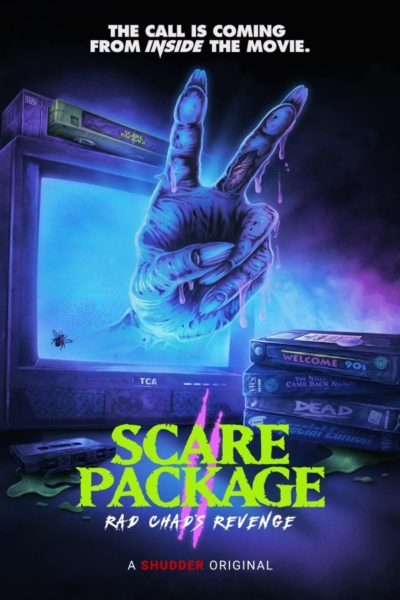 That’s the bad news mostly out of the way. “The Night He Came Back Again! Part VI: The Night She Came Back” is an enjoyable sequel to the similarly-titled entry in Scare Package, where we find that immortality runs in the family. I genuinely LOL’d at a joke involving a repeatedly-updated tombstone. But the best short is likely “We’re So Dead”, a lovely pastiche of things such as Stand By Me, depicting what would have happened if the kids there hadn’t just found a dead body… they took it back to their parents’ basement and brought it back to life – using a strangely familiar, glowing green serum. It’s an entry I was genuinely sorry to see end, and the scope for a whole feature parodying Stephen King’s many clichés is obvious.
That’s the bad news mostly out of the way. “The Night He Came Back Again! Part VI: The Night She Came Back” is an enjoyable sequel to the similarly-titled entry in Scare Package, where we find that immortality runs in the family. I genuinely LOL’d at a joke involving a repeatedly-updated tombstone. But the best short is likely “We’re So Dead”, a lovely pastiche of things such as Stand By Me, depicting what would have happened if the kids there hadn’t just found a dead body… they took it back to their parents’ basement and brought it back to life – using a strangely familiar, glowing green serum. It’s an entry I was genuinely sorry to see end, and the scope for a whole feature parodying Stephen King’s many clichés is obvious.
If the overall quality of the elements is about the same as its predecessor, I felt the wraparound story was less impressive. It seemed it had too many characters in there: the trio present in the first part felt more manageable, and this comes over as a bit overstuffed. This could be a “me” problem to some extent, since I tuned out of the Saw franchise which is its main inspiration, after the first movie. This finishes with a call for horror to be “respected”: although it’s a valid message, I very much suspect they are preaching to the choir in that regard. I still enjoyed much of this, and am keen to see where they go from here…
The film is now available on VOD, Digital, DVD and a particularly feature-iffic Blu-Ray from Shudder/ RLJE Films
